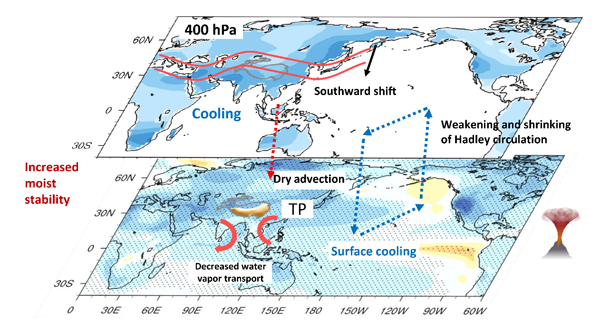中国科学院大气物理研究所大气科学和地球流体力学数值模拟国家重点实验室
State Key Laboratory of Numerical Modeling for Atmospheric Sciences and
Geophysical Fluid Dynamics (LASG)
Institute of Atmospheric Physics, Chinese Academy of Sciences
State Key Laboratory of Numerical Modeling for Atmospheric Sciences and
Geophysical Fluid Dynamics (LASG)
Institute of Atmospheric Physics, Chinese Academy of Sciences

Vol.18/No.18 December 2022
Scientists Find Decreased Summer Rainfall over the Tibetan Plateau after Large Tropical Volcanic Eruptions
This work is recently published in Climate Dynamics.
ZUO and her collaborators Prof. ZHOU Tianjun and Associate Prof. MAN Wenmin analyzed the response of summer rainfall over the Tibetan Plateau to large tropical volcanic eruptions during the last millennium by using multiple reconstructions, observations and large sets of climate model simulations. They found that both the instrumental data and proxy dataset over the past hundreds of years reveal a significant reduction in summer rainfall over the southern Tibetan Plateau during the first summer following tropical volcanic eruptions, which are further confirmed by the climate model simulations driven by volcanic forcing.
They further investigated the underlying mechanism. Both the dynamic processes related to atmospheric circulation changes and the thermodynamic processes related to specific humidity changes contribute to the decreased rainfall in the southwestern Tibetan Plateau, while the thermodynamic process dominates the reduction of rainfall in the southeastern Tibetan Plateau. The thermodynamic process results from decreased atmospheric precipitable water caused by decreased surface temperature after tropical volcanic eruptions. The dynamic processes are caused by increased gross moist stability, spatial distribution of surface cooling and a southward shift of westerlies related to weakening and shrinking of Hadley circulation following tropical eruptions.
"Our results imply that major tropical volcanic eruptions have significant impact on the summer rainfall over the southern Tibetan Plateau, which further decrease the source of supply for the glaciers and runoff output in Tibetan Plateau. We suggest potential volcanic eruptions should be included in the design of near-term decadal climate prediction experiments", ZUO concludes the findings of their study.

Schematic diagram of the mechanism for summer precipitation responses over the Tibetan Plateau following large tropical volcanic eruptions.(Image by ZUO Meng)
Citation: Zuo Meng, Tianjun Zhou*, Wenmin Man, 2022: Response of summer precipitation over the Tibetan Plateau to large tropical volcanic eruptions in the last millennium. Climate Dynamics, https://doi.org/10.1007/s00382-022-06463-2
Link:https://link.springer.com/article/10.1007/s00382-022-06463-2#article-info
Contact: ZHOU Tianjun, zhoutj@lasg.iap.ac.cn
Add: No.40, Huayanli, Beichen West Road, Chaoyang District, Beijing P.O. Box 9804, 100029, China
E-mail: lasg_newsletter@lasg.iap.ac.cn
Editors: Chuanyi Wang (wangcy@lasg.iap.ac.cn), Kangjun Chen(ckj@lasg.iap.ac.cn)
E-mail: lasg_newsletter@lasg.iap.ac.cn
Editors: Chuanyi Wang (wangcy@lasg.iap.ac.cn), Kangjun Chen(ckj@lasg.iap.ac.cn)